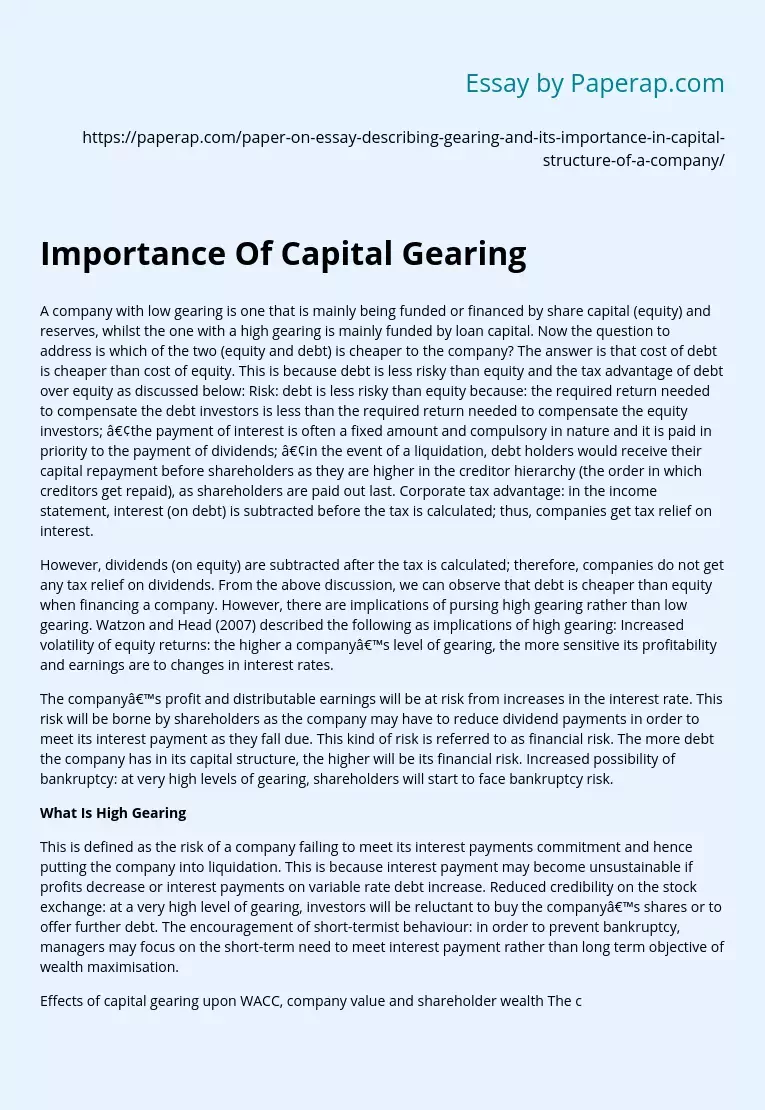Importance Of Capital Gearing
A company with low gearing is one that is mainly being funded or financed by share capital (equity) and reserves, whilst the one with a high gearing is mainly funded by loan capital. Now the question to address is which of the two (equity and debt) is cheaper to the company? The answer is that cost of debt is cheaper than cost of equity. This is because debt is less risky than equity and the tax advantage of debt over equity as discussed below: Risk: debt is less risky than equity because: the required return needed to compensate the debt investors is less than the required return needed to compensate the equity investors; •the payment of interest is often a fixed amount and compulsory in nature and it is paid in priority to the payment of dividends; •in the event of a liquidation, debt holders would receive their capital repayment before shareholders as they are higher in the creditor hierarchy (the order in which creditors get repaid), as shareholders are paid out last.
Corporate tax advantage: in the income statement, interest (on debt) is subtracted before the tax is calculated; thus, companies get tax relief on interest.
However, dividends (on equity) are subtracted after the tax is calculated; therefore, companies do not get any tax relief on dividends. From the above discussion, we can observe that debt is cheaper than equity when financing a company. However, there are implications of pursing high gearing rather than low gearing. Watzon and Head (2007) described the following as implications of high gearing: Increased volatility of equity returns: the higher a company’s level of gearing, the more sensitive its profitability and earnings are to changes in interest rates.
The company’s profit and distributable earnings will be at risk from increases in the interest rate. This risk will be borne by shareholders as the company may have to reduce dividend payments in order to meet its interest payment as they fall due. This kind of risk is referred to as financial risk. The more debt the company has in its capital structure, the higher will be its financial risk. Increased possibility of bankruptcy: at very high levels of gearing, shareholders will start to face bankruptcy risk.
What Is High Gearing
This is defined as the risk of a company failing to meet its interest payments commitment and hence putting the company into liquidation. This is because interest payment may become unsustainable if profits decrease or interest payments on variable rate debt increase. Reduced credibility on the stock exchange: at a very high level of gearing, investors will be reluctant to buy the company’s shares or to offer further debt. The encouragement of short-termist behaviour: in order to prevent bankruptcy, managers may focus on the short-term need to meet interest payment rather than long term objective of wealth maximisation.
Effects of capital gearing upon WACC, company value and shareholder wealth The capital structure of a company refers to the mixture of equity and debt finance used by the company to finance its assets. Some companies could be all-equity-financed and have no debt at all, whilst others could have low levels of equity and high levels of debt. The decision on what mixture of equity and debt capital to have is called the financing decision. The financing decision has a direct effect on the weighted average cost of capital (WACC).
The weighted-average cost of capital (WACC) represents the overall cost of capital for a company, incorporating the costs of equity, debt and preference share capital, weighted according to the proportion of each source of finance within the business (Cornelius, 2002). The weightings are in proportion to the market values of equity and debt; therefore, as the proportions of equity and debt vary so will the WACC. Therefore the first major point to understand is that, as a company changes its capital structure (i. . varies the mixture of equity and debt finance), it will automatically result in a change in its WACC. It is important to note that the financing decision (i. e. altering the capital structure) affects the overall objective of maximizing shareholder wealth. This is based on the ground that wealth is the present value of future cash flows discounted at the investor’s required return. The market value of a company is equal to the present value of its future cash flows discounted by its WACC.
It is fundamental to note that the lower the WACC, the higher the market value of the company, and vice versa. Therefore, a change in the capital structure to lower the WACC can then increase the market value of the company and thus increase shareholder wealth. As a result, the search for optimal capital structure becomes the search for the lowest WACC, because when the WACC is minimized, the value of the company and shareholder wealth is maximized. Hence, it is the responsibility of finance managers to find the optimal capital structure that will result in the lowest WACC.
Importance Of Capital Gearing. (2019, Dec 05). Retrieved from https://paperap.com/paper-on-essay-describing-gearing-and-its-importance-in-capital-structure-of-a-company/

